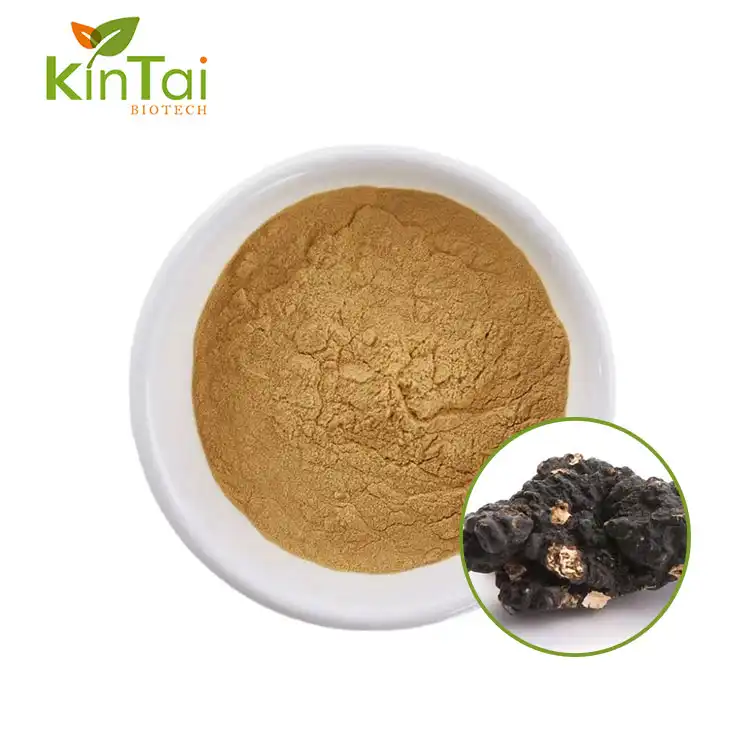Is Oleanolic Acid Powder Safe For Skin?
2024-11-19 16:59:26
Oleanolic acid powder has gained significant attention in the skincare industry due to its potential benefits for skin health. As a naturally occurring triterpenoid compound found in various plants, including olive leaves and fruit skins, oleanolic acid has been studied for its anti-inflammatory, antioxidant, and anti-aging properties. However, many people wonder about its safety when applied to the skin. In this blog post, we'll explore the safety and efficacy of oleanolic acid powder for skincare use, addressing common concerns and providing insights based on scientific research and expert opinions.

What are the benefits of oleanolic acid for skin?
Oleanolic acid offers several potential benefits for skin health, making it an attractive ingredient in skincare formulations. Here are some of the key advantages associated with oleanolic acid:
-
Anti-inflammatory properties: Oleanolic acid has been shown to possess potent anti-inflammatory effects, which can help soothe irritated skin and reduce redness. This property makes it particularly beneficial for individuals with sensitive or acne-prone skin, as it may help calm inflammation associated with breakouts and other skin conditions.
-
Antioxidant protection: As a powerful antioxidant, oleanolic acid helps protect the skin from free radical damage caused by environmental stressors such as UV radiation and pollution. By neutralizing these harmful molecules, it may help prevent premature aging and maintain overall skin health.
-
Anti-aging effects: Oleanolic acid has been found to stimulate collagen production and improve skin elasticity. These effects can contribute to a reduction in the appearance of fine lines and wrinkles, promoting a more youthful complexion.
-
Wound healing: Some studies suggest that oleanolic acid may promote wound healing by enhancing the proliferation and migration of skin cells. This property could be beneficial for treating minor skin injuries and improving overall skin repair processes.
-
Sebum regulation: Oleanolic acid has been shown to help regulate sebum production, which can be particularly beneficial for individuals with oily or acne-prone skin. By balancing oil production, it may help reduce the occurrence of clogged pores and breakouts.
-
Skin barrier support: Research indicates that oleanolic acid powder may help strengthen the skin's natural barrier function, which is crucial for maintaining hydration and protecting against external irritants.

These benefits make oleanolic acid a versatile ingredient in skincare products, addressing multiple concerns simultaneously. However, it's important to note that individual results may vary, and the effectiveness of oleanolic acid can depend on factors such as concentration, formulation, and overall skincare routine.
How does oleanolic acid compare to other anti-aging ingredients?
When considering the effectiveness of oleanolic acid as an anti-aging ingredient, it's helpful to compare it to other well-known compounds in the skincare industry. Here's how oleanolic acid stacks up against some popular anti-aging ingredients:
-
Retinoids: Retinoids, such as retinol and tretinoin, are widely regarded as gold-standard anti-aging ingredients. They work by increasing cell turnover and stimulating collagen production. While oleanolic acid also promotes collagen synthesis, it generally has a milder effect compared to retinoids. However, oleanolic acid may be better tolerated by those with sensitive skin, as it typically causes less irritation.
-
Vitamin C: Like oleanolic acid, vitamin C is a potent antioxidant that helps protect the skin from free radical damage. Both ingredients can help brighten the complexion and improve overall skin tone. However, vitamin C is known for its ability to inhibit melanin production, making it particularly effective for addressing hyperpigmentation, which is not a primary benefit of oleanolic acid.
-
Hyaluronic Acid: While hyaluronic acid is excellent for hydration and plumping the skin, oleanolic acid offers a broader range of benefits, including anti-inflammatory and sebum-regulating properties. The two ingredients can be complementary in a skincare routine, with hyaluronic acid providing intense hydration and oleanolic acid offering multiple anti-aging benefits.
-
Peptides: Both oleanolic acid and peptides can stimulate collagen production, contributing to improved skin elasticity and reduced appearance of wrinkles. However, peptides are often more targeted in their effects, with different peptides addressing specific skin concerns. Oleanolic acid, on the other hand, offers a more comprehensive approach to skin health.
-
Alpha Hydroxy Acids (AHAs): AHAs, such as glycolic and lactic acid, primarily work by exfoliating the skin and promoting cell turnover. While this can lead to improved skin texture and tone, oleanolic acid's benefits are more focused on skin protection and repair. Combining oleanolic acid powder with gentle AHAs could provide a well-rounded approach to skin rejuvenation.

It's worth noting that oleanolic acid's unique combination of anti-inflammatory, antioxidant, and collagen-boosting properties sets it apart from many other anti-aging ingredients. Its ability to address multiple skin concerns simultaneously makes it a valuable addition to skincare formulations. Moreover, its natural origin and generally good tolerability profile may appeal to consumers seeking plant-based skincare solutions.
When comparing the effectiveness of anti-aging ingredients, it's important to consider that results can vary significantly between individuals. Factors such as skin type, age, environmental exposure, and overall skincare routine play crucial roles in determining the efficacy of any ingredient. Additionally, the concentration and formulation of the product containing oleanolic acid or other anti-aging compounds can greatly influence their effectiveness.
For optimal results, many dermatologists recommend a multi-faceted approach to anti-aging skincare, combining different ingredients that target various aspects of skin aging. Oleanolic acid can be an excellent component of such a routine, working synergistically with other proven anti-aging ingredients to promote overall skin health and appearance.
Can oleanolic acid cause skin irritation or allergic reactions?
When considering the use of any new skincare ingredient, it's natural to be concerned about potential side effects, including skin irritation or allergic reactions. In the case of oleanolic acid, research and clinical experience suggest that it is generally well-tolerated by most skin types. However, as with any skincare ingredient, there is always a possibility of individual sensitivities or reactions. Here's a closer look at the potential for skin irritation or allergic reactions with oleanolic acid:
-
Low irritation potential: Oleanolic acid is known for its gentle nature and is often well-tolerated even by those with sensitive skin. Its anti-inflammatory properties may actually help soothe irritated skin, making it less likely to cause irritation compared to some other active skincare ingredients.
-
Rare allergic reactions: While allergic reactions to oleanolic acid powder are uncommon, they are not impossible. As with any plant-derived compound, some individuals may have a specific sensitivity or allergy to oleanolic acid or related substances.
-
Patch testing: To minimize the risk of adverse reactions, it's always recommended to perform a patch test before incorporating a new product containing oleanolic acid into your skincare routine. Apply a small amount of the product to a discreet area of skin, such as behind the ear or on the inner forearm, and monitor for any signs of irritation or allergic reaction for 24-48 hours.
-
Concentration matters: The concentration of oleanolic acid in a product can influence its potential for irritation. Higher concentrations may be more likely to cause irritation in sensitive individuals. Most skincare products contain relatively low concentrations of oleanolic acid, which helps maintain its gentle nature.
-
Formulation factors: The overall formulation of a skincare product containing oleanolic acid can also impact its potential for irritation. Products that are well-formulated with soothing and hydrating ingredients may help mitigate any potential for irritation.
-
Individual skin factors: Skin sensitivity can vary greatly from person to person and can be influenced by factors such as skin type, existing skin conditions, and overall skin barrier health. Those with compromised skin barriers or conditions like eczema or rosacea may be more prone to irritation from any new skincare ingredient.
-
Cumulative effects: In some cases, irritation may develop over time with repeated use, especially if the product is overused or combined with other potentially irritating ingredients. It's important to introduce new products gradually and monitor your skin's response.
While the risk of skin irritation or allergic reactions to oleanolic acid is generally low, it's always important to listen to your skin and discontinue use if you experience any persistent redness, itching, burning, or other signs of irritation. If you have particularly sensitive skin or a history of allergic reactions to skincare products, it may be wise to consult with a dermatologist before incorporating oleanolic acid into your routine.

It's also worth noting that the safety and efficacy of oleanolic acid can be influenced by the quality of the ingredient and the overall formulation of the product. Choosing products from reputable manufacturers who adhere to good manufacturing practices and use high-quality ingredients can help minimize the risk of adverse reactions.
In conclusion, while oleanolic acid powder is generally considered safe for skin use and offers numerous potential benefits, it's always important to approach new skincare ingredients with caution. By being aware of your skin's needs and reactions, performing patch tests, and introducing new products gradually, you can safely explore the potential benefits of oleanolic acid for your skin health and appearance.
Kintai Healthtech Inc. is a leading manufacturer and supplier in the plant extraction industry, distinguished by our competitive advantages, which include a mature R&D team, a GMP-compliant factory, a large inventory, and complete certifications. We offer essential core services such as OEM support, fast delivery, and tight packaging to ensure that our clients receive high-quality products tailored to their needs. Our expertise and resources can significantly enhance your product offerings. For more details, please consult us at info@kintaibio.com. We look forward to the opportunity to work with you!
References
- Pollier, J., & Goossens, A. (2012). Oleanolic acid. Phytochemistry, 77, 10-15.
- Yadav, E., Singh, D., Yadav, P., & Verma, A. (2018). Attenuation of dermal wounds via downregulating oxidative stress and inflammatory markers by protocatechuic acid rich n-butanol fraction of Trianthema portulacastrum Linn. in wistar albino rats. Biomedicine & Pharmacotherapy, 108, 757-766.
- Seo, D. Y., Lee, S. R., Heo, J. W., No, M. H., Rhee, B. D., Ko, K. S., ... & Han, J. (2018). Ursolic acid in health and disease. Korean Journal of Physiology & Pharmacology, 22(3), 235.
- Jäger, S., Trojan, H., Kopp, T., Laszczyk, M. N., & Scheffler, A. (2009). Pentacyclic triterpene distribution in various plants–rich sources for a new group of multi-potent plant extracts. Molecules, 14(6), 2016-2031.
- Chudzik, M., Korzonek-Szlacheta, I., & Król, W. (2015). Triterpenes as potentially cytotoxic compounds. Molecules, 20(1), 1610-1625.
- Luo, H., Cai, C., Zhang, J., & Mo, W. (2019). Oleanolic acid ameliorates oxidative stress and enhances antioxidant ability in human umbilical vein endothelial cells. Journal of Huazhong University of Science and Technology [Medical Sciences], 39(1), 37-43.
- Ayeleso, T. B., Matumba, M. G., & Mukwevho, E. (2017). Oleanolic acid and its derivatives: biological activities and therapeutic potential in chronic diseases. Molecules, 22(11), 1915.
- Rodríguez-Rodríguez, R. (2015). Oleanolic acid and related triterpenoids from olives on vascular function: molecular mechanisms and therapeutic perspectives. Current Medicinal Chemistry, 22(11), 1414-1425.
- Yang, S., Zhang, J., Yan, Y., Yang, M., Li, C., Li, J., ... & Huang, L. (2019). Network pharmacology-based strategy to investigate the pharmacologic mechanisms of atractylodes macrocephala Koidz. for the treatment of chronic gastritis. Frontiers in Pharmacology, 10, 1629.
- Castellano, J. M., Guinda, A., Delgado, T., Rada, M., & Cayuela, J. A. (2013). Biochemical basis of the antidiabetic activity of oleanolic acid and related pentacyclic triterpenes. Diabetes, 62(6), 1791-1799.









